Home > Drawing Directory Home> Drawing Nature > Drawing Figures in Landscapes
Figure Drawing in Open Landscapes: how to draw peopele and other figures outside
|
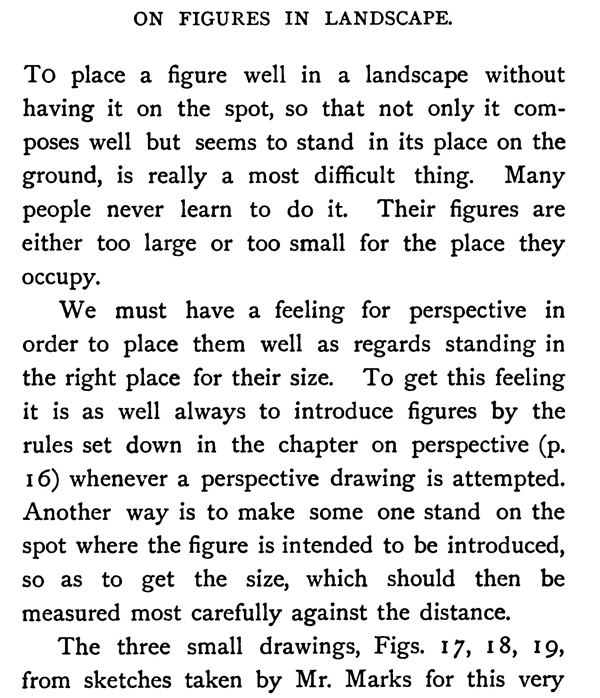
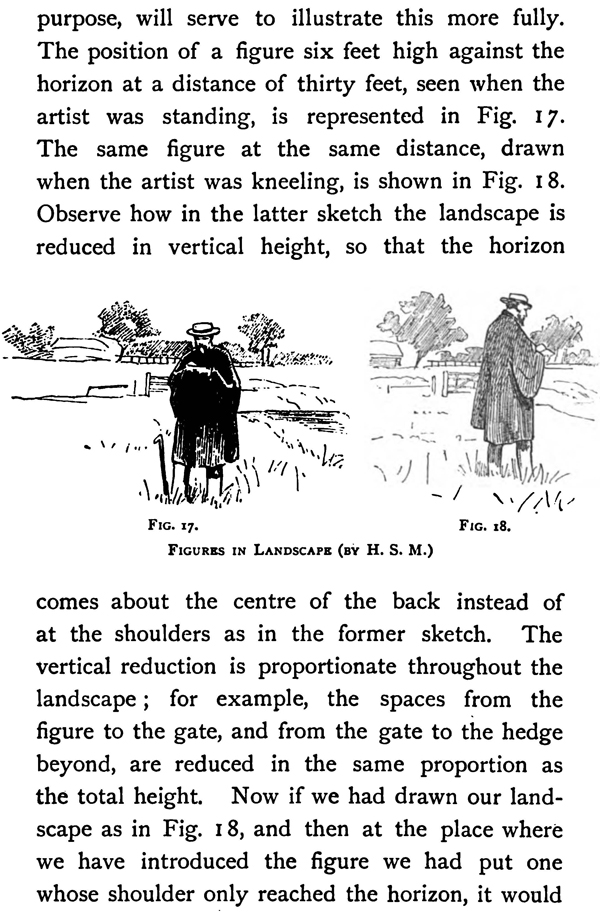
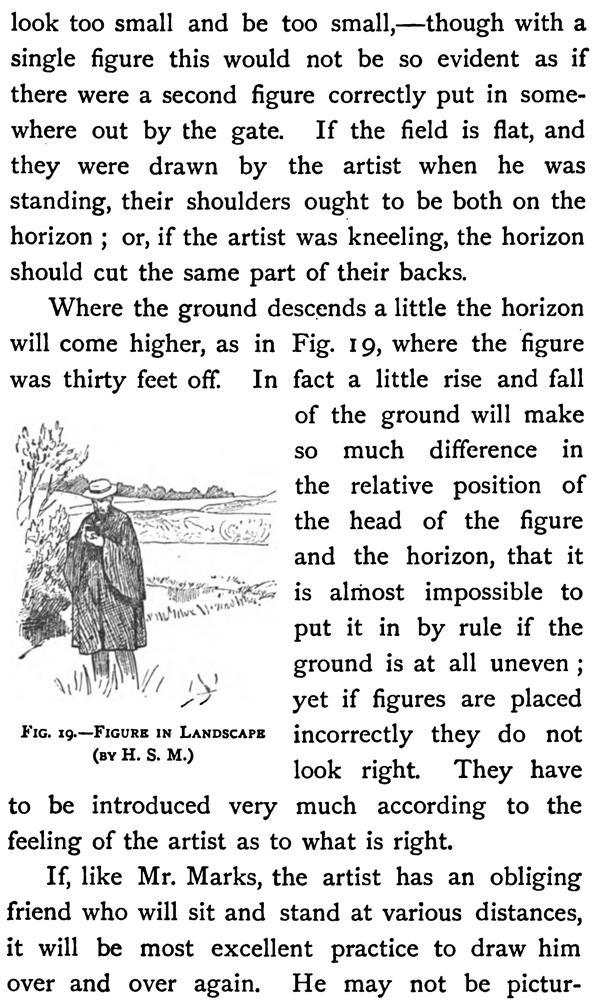
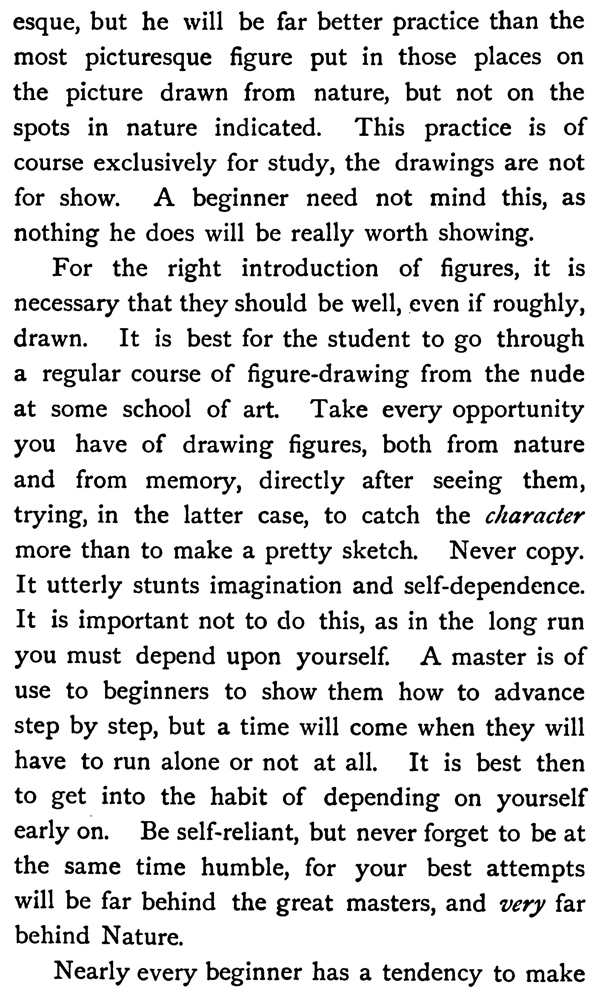
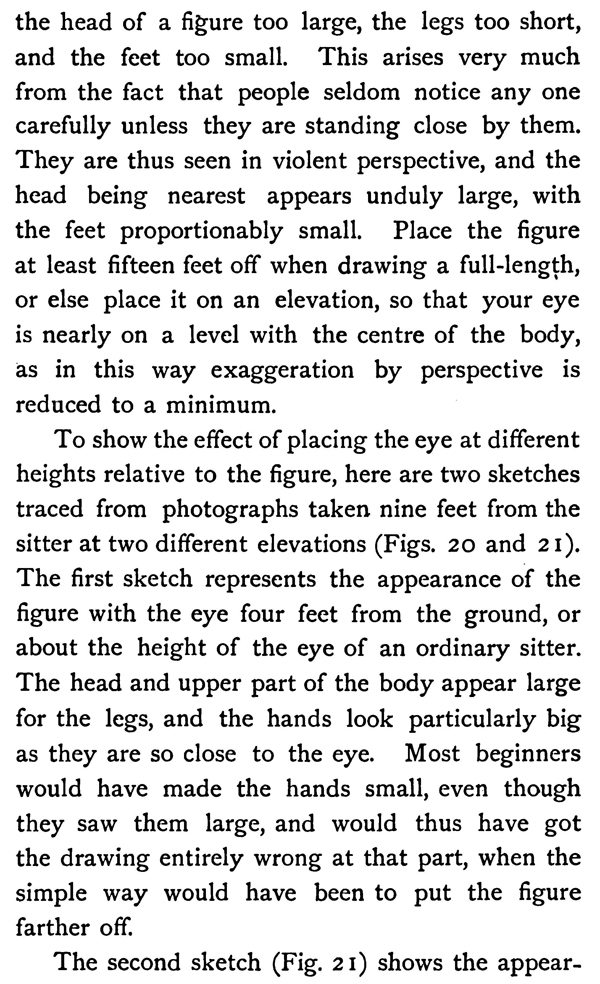
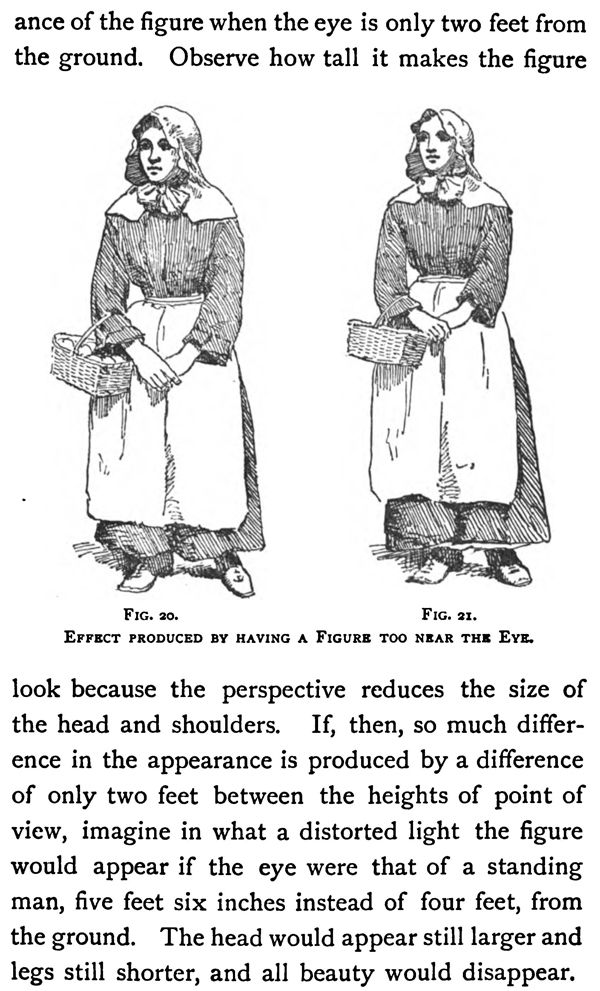
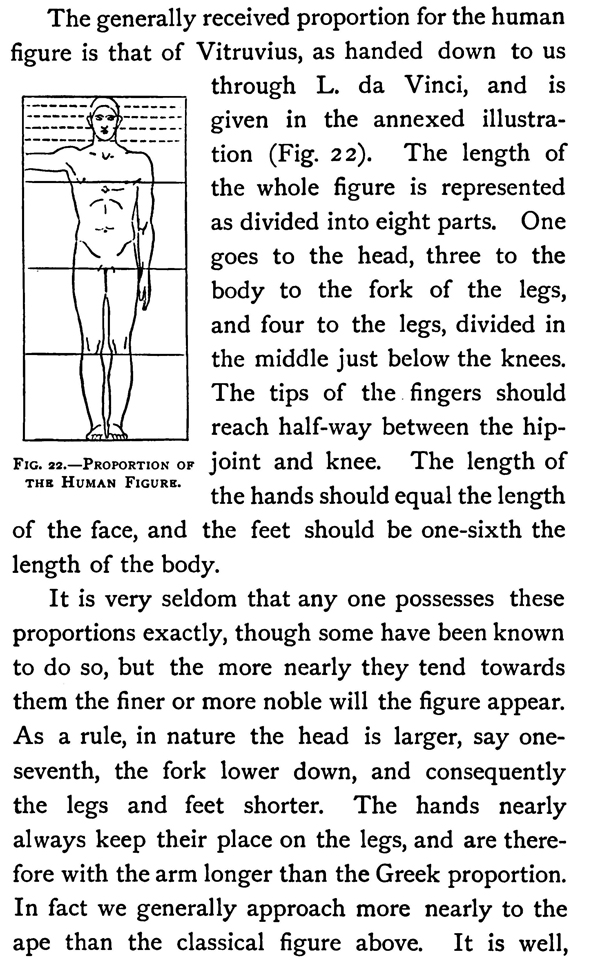
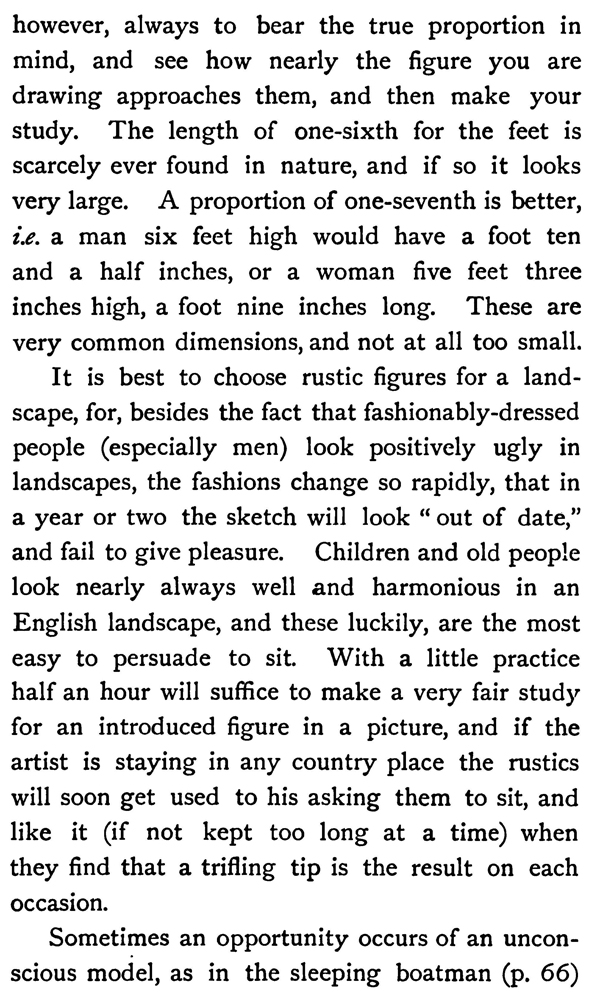
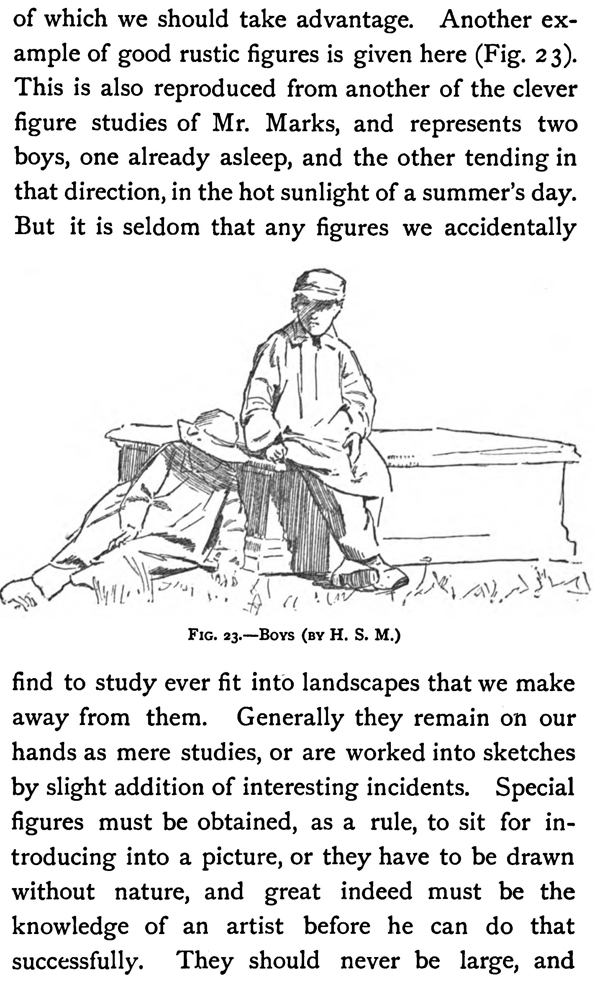


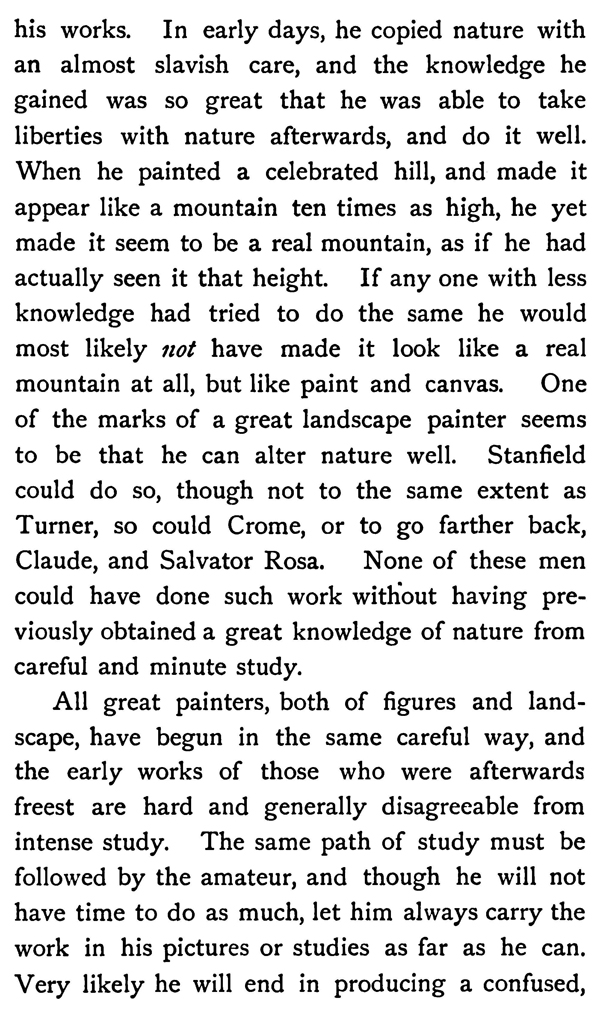
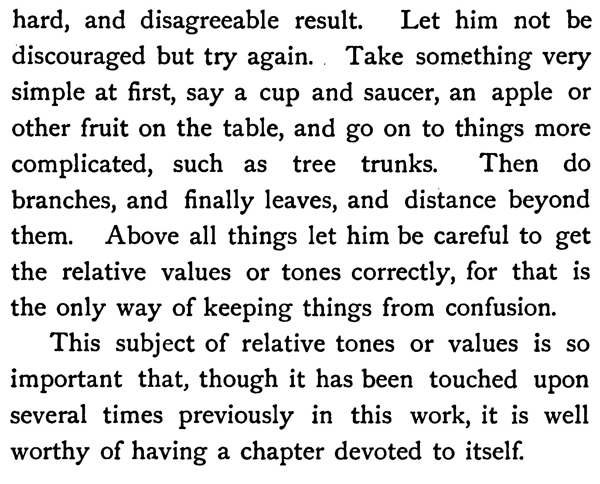
GO BACK TO THE HOME PAGE FOR TUTORIALS FOR BEGINNING ARTISTS
[The above words are pictures of text, below is the actual text if you need to copy a paragraph or two]
ON FIGURES IN LANDSCAPE.
To place a figure well in a landscape without having it on the spot, so that not only it composes well but seems to stand in its place on the ground, is really a most difficult thing. Many people never learn to do it. Their figures are either too large or too small for the place they occupy.
We must have a feeling for perspective in order to place them well as regards standing in the right place for their size. To get this feeling it is as well always to introduce figures by the rules set down in the chapter on perspective (p. 16) whenever a perspective drawing is attempted. Another way is to make some one stand on the spot where the figure is intended to be introduced, so as to get the size, which should then be measured most carefully against the distance.
The three small drawings, Figs. 17, 18, 19, from sketches taken by Mr. Marks for this very purpose, will serve to illustrate this more fully. The position of a figure six feet high against the horizon at a distance of thirty feet, seen when the artist was standing, is represented in Fig. 17. The same figure at the same distance, drawn when the artist was kneeling, is shown in Fig. 18. Observe how in the latter sketch the landscape is reduced in vertical height, so that the horizon comes about the centre of the back instead of at the shoulders as in the former sketch. The vertical reduction is proportionate throughout the landscape; for example, the spaces from the figure to the gate, and from the gate to the hedge beyond, are reduced in the same proportion as the total height. Now if we had drawn our landscape as in Fig. 18, and then at the place where we have introduced the figure we had put one whose shoulder only reached the horizon, it would look too small and be too small,—though with a single figure this would not be so evident as if there were a second figure correctly put in somewhere out by the gate. If the field is flat, and they were drawn by the artist when he was standing, their shoulders ought to be both on the horizon ; or, if the artist was kneeling, the horizon should cut the same part of their backs.
Where the ground descends a little the horizon will come higher, as in Fig. 19, where the figure was thirty feet off. In fact a little rise and fall of the ground will make; so much difference in the relative position of the head of the figure and the horizon, that it is almost impossible to put it in by rule if the ground is at all uneven; yet if figures are placed incorrectly they do not look right. They have to be introduced very much according to the feeling of the artist as to what is right.
If, like Mr. Marks, the artist has an obliging friend who will sit and stand at various distances, it will be most excellent practice to draw him over and over again. He may not be picturesque, but he will be far better practice than the most picturesque figure put in those places on the picture drawn from nature, but not on the spots in nature indicated. This practice is of course exclusively for study, the drawings are not for show. A beginner need not mind this, as nothing he does will be really worth showing.
For the right introduction of figures, it is necessary that they should be well, even if roughly, drawn. It is best for the student to go through a regular course of figure-drawing from the nude at some school of art. Take every opportunity you have of drawing figures, both from nature and from memory, directly after seeing them, trying, in the latter case, to catch the character more than to make a pretty sketch. Never copy. It utterly stunts imagination and self-dependence. It is important not to do this, as in the long run you must depend upon yourself. A master is of use to beginners to show them how to advance step by step, but a time will come when they will have to run alone or not at all. It is best then to get into the habit of depending on yourself early on. Be self-reliant, but never forget to be at the same time humble, for your best attempts will be far behind the great masters, and very far behind Nature.
Nearly every beginner has a tendency to make the head of a figure too large, the legs too short, and the feet too small. This arises very much from the fact that people seldom notice any one carefully unless they are standing close by them. They are thus seen in violent perspective, and the head being nearest appears unduly large, with the feet proportionably small. Place the figure at least fifteen feet off when drawing a full-length, or else place it on an elevation, so that your eye is nearly on a level with the centre of the body, as in this way exaggeration by perspective is reduced to a minimum.
To show the effect of placing the eye at different heights relative to the figure, here are two sketches traced from photographs taken nine feet from the sitter at two different elevations (Figs. 20 and 21). The first sketch represents the appearance of the figure with the eye four feet from the ground, or about the height of the eye of an ordinary sitter. The head and upper part of the body appear large for the legs, and the hands look particularly big as they are so close to the eye. Most beginners would have made the hands small, even though they saw them large, and would thus have got the drawing entirely wrong at that part, when the simple way would have been to put the figure farther off.
FIG. 21. EFFECT PRODUCED BY HAVING A FIGURE TOO NEAR THE EYE.
The second sketch (Fig. 21) shows the appearante of the figure when the eye is only two feet from the ground. Observe how tall it makes the figure FIG. 20.
look because the perspective reduces the size of the head and shoulders. If, then, so much difference in the appearance is produced by a difference of only two feet between the heights of point of view, imagine in what a distorted light the figure would appear if the eye were that of a standing man, five feet six inches instead of four feet, from the ground. The head would appear still larger and legs still shorter, and all beauty would disappear.
The generally received proportion for the human figure is that of Vitruvius, as handed down to us through L. da Vinci, and is given in the annexed illustrations.
The length of the whole figure is represented as divided into eight parts. One goes to the head, three to the body to the fork of the legs, and four to the legs, divided in the middle just below the knees.
THE HUMAN FIGURE.
FIG. 22.-PROPORTION OF joint and knee.
The length of the hands should equal the length of the face, and the feet should be one-sixth the length of the body.
It is very seldom that any one possesses these proportions exactly, though some have been known to do so, but the more nearly they tend towards them the finer or more noble will the figure appear. As a rule, in nature the head is larger, say one-seventh, the fork lower down, and consequently the legs and feet shorter. The hands nearly always keep their place on the legs, and are therefore with the arm longer than the Greek proportion. In fact we generally approach more nearly to the ape than the classical figure above. It is well, however, always to bear the true proportion in mind, and see how nearly the figure you are drawing approaches them, and then make your study. The length of one-sixth for the feet is scarcely ever found in nature, and if so it looks very large. A proportion of one-seventh is better, i.e. a man six feet high would have a foot ten and a half inches, or a woman five feet three inches high, a foot nine inches long. These are very common dimensions, and not at all too small.
It is best to choose rustic figures for a landscape, for, besides the fact that fashionably-dressed people (especially men) look positively ugly in landscapes, the fashions change so rapidly, that in a year or two the sketch will look " out of date," and fail to give pleasure. Children and old people look nearly always well and harmonious in an English landscape, and these luckily, are the most easy to persuade to sit. With a little practice half an hour will suffice to make a very fair study for an introduced figure in a picture, and if the artist is staying in any country place the rustics will soon get used to his asking them to sit, and like it (if not kept too long at a time) when they find that a trifling tip is the result on each occasion.
Sometimes an opportunity occurs of an unconscious model, as in the sleeping boatman.
of which we should take advantage. Another example of good rustic figures is given here (Fig. 23). This is also reproduced from another of the clever figure studies of Mr. Marks, and represents two boys, one already asleep, and the other tending in that direction, in the hot sunlight of a summer's day. But it is seldom that any figures we accidentally find to study ever fit into landscapes that we make away from them. Generally they remain on our hands as mere studies, or are worked into sketches by slight addition of interesting incidents. Special figures must be obtained, as a rule, to sit for introducing into a picture, or they have to be drawn without nature, and great indeed must be the knowledge of an artist before he can do that successfully. They should never be large, and should be more blocked in than drawn in. Animals, again, are even more difficult than figures, and should only be introduced after a great deal of individual study.
Photographs, especially if they be instantaneous, give a great help to the study of animals, and for a black and white drawing they may be sometimes directly copied. (This may be considered as an exception to the rule given above.) Good photographs are always instructive, the drawing is so beautifully correct in details.
After turning over many, if they be well selected, it feels almost impossible to look at sketches except by the very first masters. It is said that " a photograph cannot lie;" but this is certainly not the fact. A representation of nature to be good must be true in relative values of light and shade, as well as true in drawing. Now in the former particular photographs are often very wrong indeed. The clearer the air and brighter the colours the farther from nature they are. If, for example, we photograph a dahabieh or Nile boat seen in full sunlight with its white sail shining out dazzlingly against the deep blue sky, and reflected with almost equal brilliancy in the water, we shall get a photograph in which the sail will most likely appear slightly darker than the sky, and the reflection will disappear altogether.
Again, a bright orange dress against an intense blue door will look like a dark dress against a pale door. In actual drawing, also, a photograph will be sometimes misleading, as mentioned (p. 8 I), and it is well known how a building may be made to look of a monstrous size, when it is really small, simply by contrivance in placing the figures, and the height at which the camera stands, or high mountains may look poor and low by introducing too much foreground.
On taking liberties with nature.—A great service has been done to art by photography. The public are more critical in the matter of character and drawing, and are better able to weed out the bad pictures from the good. At one time artists used to take liberties with nature in a way that would not be permitted for a moment now. The great arch-liberty-taker was Turner. He would put the sun, moon, and stars, into one sky if it helped his composition or interest. He would put trees growing in impossible places, and in making a view of a well-known town would put that which was behind him into the view in front, and he would pile up hills till they were mountains. Any one who now did the same things would not have his pictures looked at. And yet Turner is a great man, and we always gather knowledge and strength from looking at his works. In early days, he copied nature with an almost slavish care, and the knowledge he gained was so great that he was able to take liberties with nature afterwards, and do it well.
When he painted a celebrated hill, and made it appear like a mountain ten times as high, he yet made it seem to be a real mountain, as if he had actually seen it that height. If any one with less knowledge had tried to do the same he would most likely not have made it look like a real mountain at all, but like paint and canvas. One of the marks of a great landscape painter seems to be that he can alter nature well. Stanfield could do so, though not to the same extent as Turner, so could Crome, or to go farther back, Claude, and Salvator Rosa. None of these men could have done such work without having previously obtained a great knowledge of nature from careful and minute study.
All great painters, both of figures and landscape, have begun in the same careful way, and the early works of those who were afterwards freest are hard and generally disagreeable from intense study. The same path of study must be followed by the amateur, and though he will not have time to do as much, let him always carry the work in his pictures or studies as far as he can. Very likely he will end in producing a confused, hard, and disagreeable result. Let him not be discouraged but try again. Take something very simple at first, say a cup and saucer, an apple or other fruit on the table, and go on to things more complicated, such as tree trunks. Then do branches, and finally leaves, and distance beyond them. Above all things let him be careful to get the relative values or tones correctly, for that is the only way of keeping things from confusion.
This subject of relative tones or values is so important that, though it has been touched upon several times previously in this work, it is well worthy of having a chapter devoted to itself.
Privacy Policy ..... Contact Us




